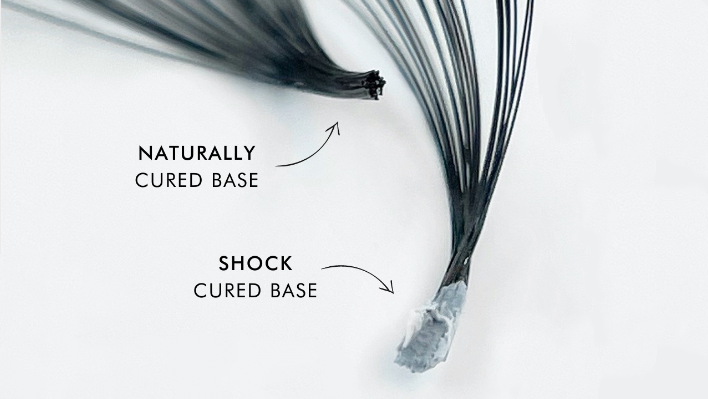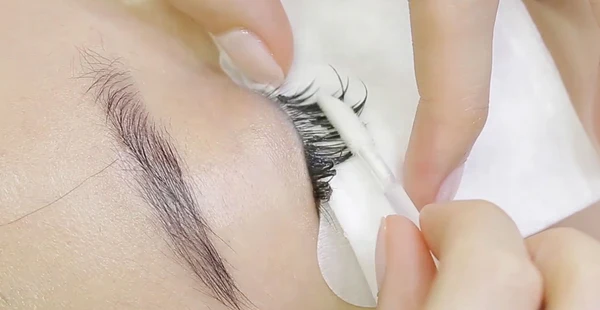Blog
Eyelash Glue Tips: How To Avoid Shock Polymerization
Shock! Horror! There’s nothing worse than eyelash extensions that set faster than you’re able to apply them. Yes, we’re talking about shock polymerisation, also known as shock curing.
Shock polymerisation occurs when lash glue cures and hardens too fast due to certain environmental or chemical factors. This unfortunate issue can cause rapid curing, poor lash bonding, clumpy lashes, and messy, unsatisfying results.
But that doesn’t mean there aren’t ways to fix it!
Learning about this unideal phenomenon and how to avoid and fix it can help you elevate your lash game to the next level and deliver gorgeous, long-lasting lash results to your clients—soft, symmetrical, and perfectly cured—every time.

What Is Shock Polymerisation In Lash Glue?
Shock polymerisation of eyelash extension glue is the lightning-fast process where your eyelash glue goes from the malleable liquid you need it to be whilst you’re perfecting your lash extension placement, to solid in the blink of an eye and locking those lash extensions in place before you’re ready!

The Causes Of Shock Polymerisation: Why Shock Polymerisation Lashes Occur
Understanding why shock polymerisation lashes occur is important for every lash technician. Once you know why it happens, you can approach lash adhesives with elevated expertise and an even better strategy for creating fabulous, neat, and firmly bonded lashes.
These are the things to watch out for when applying lashes so that you avoid shock curing and prevent the cyanoacrylate in your lash glue from turning white and clumpy:
- Improper lash glue storage conditions
You can always tell a lash artist by the way they store their lash glue! If your lash glue collection is not properly stored (such as being left unsealed, stored in a warm place, or left exposed to the sun), it can activate the cyanoacrylate molecules and increase the likelihood of shock curing. - Sudden change in temperature
It’s always best to perform eyelash extension applications in a room with a cool, controlled temperature. Too much heat will cause shock polymerisation, and too much coldness will prevent your adhesive from curing at all.
Setting lashes outside exposes you to too many sudden changes in temperature (and the wind or rain won’t help!). Lash glue is extremely temperature-sensitive. The best temperature range to apply lash extensions in is 20-25 degrees Celsius. - Too much moisture
Moisture and lash glue don’t really see eye to eye. When they come into contact with each other, the glue tightens up too quickly.
The only times moisture and lash glue may come into contact are if a client’s eyes start watering or you start to wash your client’s lashes before all of the glue has been removed. Either way, shock polymerisation is likely to occur.
How Can You Prevent Shock Polymerisation Of Eyelash Glue?
Now that we know the ins and outs, how can you prevent shock polymerisation from wreaking havoc on your lash game? Here are some of our top tips and tricks to prevent it from getting the best of us:
💡Proper adhesive storage
Knowing how to store eyelash glue correctly is crucial! Investing in high-quality lash glue is one thing, but without a proper storage technique, your adhesives may become vulnerable to shock polymerisation.
The general rule of thumb for adhesive storage is to place your bottles upright in a cool, dry, and secure place. Always seal them properly after using them, and if they get a bit gunky, use nozzle wipes to keep the nozzle clean. Care is key!
💡Begin With The Outer Corners Of The Lashes
On the lashes, it’s most common for shock polymerisation to occur in the outer corners as the client’s eyes begin to water. To help prevent this, begin with the outer corners – it’s quite common for a client’s eyes to water towards the end of treatment due to the bright light, having to have their eyes closed for so long, glue fumes etc. – covering these lashes first gives the glue there a bit of time to cure before the eyes begin to water. Try to check from time to time during the treatment in case the eyes have begun to water, and blot the lashes with tissue just to keep the lashes as dry as possible.
💡Control Your Salon Temperature
Keep your beauty room at a consistent temperature with a Digital Hygrometer and Thermometer that helps you keep an eye on your lash room’s temperature and humidity levels so you can avoid sudden fluctuations in your salon’s conditions that will trigger the shock polymerisation of your lash glue.
💡Choose the Right Eyelash Glue
To be a successful Lash Tech with amazing lash extension retention, it’s important to make sure that you are using the correct lash glue with a drying speed that matches the pace of your lash application and will still work at its best within the conditions of your beauty room.
How To Fix Shock Polymerisation
So, we now know how to avoid shock curing, but how do we fix it when it unavoidably occurs?
Unfortunately, if shock polymerisation of your lash glue has already occurred, there isn’t a quick fix solution. You’ll have to remove all of the lash extensions with lash glue bonds that have been polymerised and re-apply them. First of all, you’ll need to tape back the lashes that you don’t want to be removed. Then, using an eyelash extension remover, add a small amount onto a microfiber eyelash brush, dab it onto the white eyelash glue residue and let it work its magic. Once the lash glue bonds have been dissolved and you have removed the lashes, you’ll then need to re-do your pretreatment on the natural lashes to remove the leftover lash glue residue and prep them again for new lash extensions to be applied. Only when the natural lashes are dry can you get back to it with your eyelash glue and re-apply those lashes.

Stop The Shock!
Lash application is a complex cosmetic art that requires a range of technical, creative, and sometimes even chemistry-related skills.
Shock polymerisation is a fairly common issue, but there are lots of ways to avoid it from happening and fix it when it does occur.
Even the most experienced and professional lash artists can encounter shock polymerisation from time to time, so don’t lose heart if the dreaded chemical reaction happens to you. Use this guide to enhance your adhesive knowledge and keep your lash applications shock-free!
